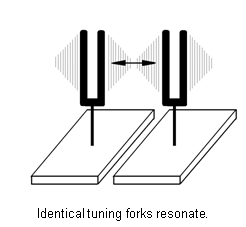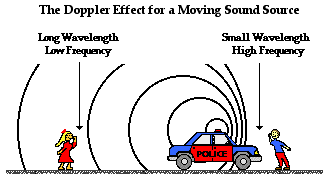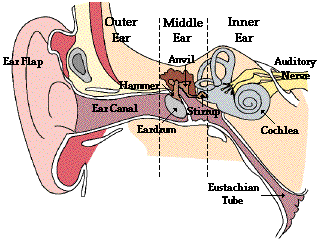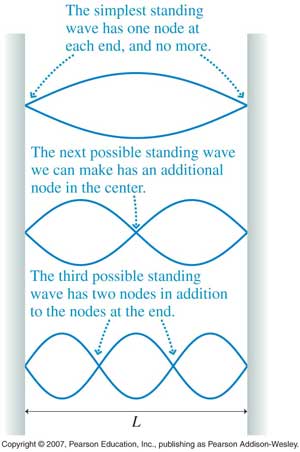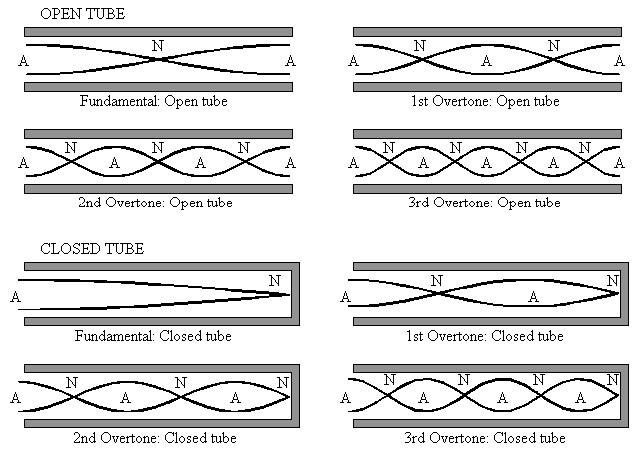Openphysics/Sound
Ultrasound and the Doppler Effect Ultrasonic waves (ultrasound) are sound waves with a frequency greater than 20 000 Hz (the upper limit of human hearing). These waves can be used in medicine to determine the direction of blood flow. The device, called a Doppler flow meter, sends out sound waves. The sound waves can travel through skin and tissue and will be reflected by moving objects in the body (like blood). The reflected waves return to the flow meter where its frequency (received frequency) is compared to the transmitted frequency. Because of the Doppler effect, blood that is moving towards the flow meter will change the sound to a higher frequency and blood that is moving away from the flow meter will cause a lower frequency.
The Doppler Effect with Sound
|
- ↑ “Free High School Science Texts”fckLRPermission is granted to copy, distribute and/or modify this document under thefckLRterms of the GNU Free Documentation License, Version 1.2 or any later versionfckLRpublished by the Free Software Foundation; with no Invariant Sections, no Front-fckLRCover Texts, and no Back-Cover Texts. A copy of the license is included in thefckLRsection entitled “GNU Free Documentation License”.
Contents
Sound Waves
Defintion
Longitudinal Mechanical Waves
Sound is a longitudinal mechanical wave. Longitudinal mechanical waves are one type out of the usual two different types of waves; mechanical and electromagnetic. Mechanical waves are waves that result from the vibration of a physical medium. Longitudinal waves are are waves in which disturbances are created due to regions of compressions and expansions, parallel to the disturbances themselves. With sound, pressure differences are created due to vibrations of objects in the air. The air is then expanded and contracted due to the pressure differences. This impacts our ears, and as a result, we hear sound.
Take thunder for example. Thunder always follows lightening. Here's why: Lightening bolts are very high in temperature. This extreme temperature causes an expansion of air. The expansion of the air due to the pressure difference from the lightening bolt creates the sound of thunder. Therefore, thunder is a resultant of lightening.
The Study of Sound
The study of sound is called acoustics. Sound waves are also sometimes called acoustical waves.
Temperature's Affect on Sound
When one studies sound, they will find that sound is temperature dependent. This is because sound is "carried" by air molecules. The velocity of the sound in air is directly affected by the temperature of the air. When the temperature rises, the velocity of the sound rises. The velocity of sound in air at 0 degree Celcius is 331 meters per second. The velocity of sound in air increases by 0.6 meters per second with each 1 degree rise in temperature.
Sound and Speed
Sound waves are directly affected by the structure of the matter that the sound wave attempts to pass through. Sound waves travel faster through matter that has molecules that are still and nonmoving. Sound waves travel slower through matter that has molecules that have a large amount of random motion. The speed of the molecules in such matter is faster. This rigid structure of the matter causes the sound waves to travel slower. Therefore, it can be concluded that sound waves travel slower through matter such as gas, and faster through matter such as solids.
Components of a Sound wave
Frequency
The frequency of a wave is the number of waves per second.
The unit of frequency is Hertz.
Frequency = f
In terms of sound, the frequency of a sound wave determines the sound's pitch. The frequency of a wave is also related to the energy of the wave. More energy is transmitted for waves of higher frequency and less energy is transmitted for waves of lower frequency.
Frequency can be calculated using the equation:
f = 1/T or f = v/λ
Period
The period of a wave is the time required to complete one wave cycle.
The unit of period is seconds.
Period = T
Period can be calculated using the equation :
T = 1/f
Wavelength
Wavelength is the distance a wave travels during one cycle.
Wavelength is measured in meters.
Wavelength = λ
Wavelength can be calculated using the equation:
λ = v/f
Amplitude
Amplitude is the height of maximum displacement of a wave from equilibrium position.
Amplitude is measured in meters.
Amplitude = A
In terms of sound, the amplitude of a wave determines the sound's intensity, in other words, the sound's volume.
Resonance
Resonance - When one object vibrating at the same natural frequency of a second object forces that second object into vibrational motion resulting in a large vibration.
Forced Vibration - An external force applied to a system from an interconnected object in vibrational motion.
Natural Frequency - The frequency of a sytem vibrating without any external forces after being set in motion.
f0 = 1/2π (√(k/m) )
The amplitude of vibration for a forced vibration depends of the difference between the externally applied frequency and the natural frequency. The amplitude reaches a maximum when the two frequencies equal each other. (When f = fo)
Resonance caused the Tacoma Narrows Bridge to collapse in 1940 when the frequency of the wind matched the natural frequency of the bridge. The amplitude reached a maximum, causing the bridge to go into large-amplitude oscillatory motion.
Click the following link to watch a video of resonance and the Tacoma Narrows Bridge.
When a natural frequency causes a forced vibration on a larger object, there will be an increase in amplitude and loudness of the sound.
Example : The string of a guitar has it's own natural frequency. When attached to a sound box, the natural frequency of the string causes a forced vibration in the sound box. The air particles in the sound box begin to vibrate at the same natural frequency of the string, causing one large vibration that increases the amplitude and the loudness of the sound.
Resonating Tuning Forks
Say you have a tuning fork on top of a sound box. You also have a second tuning fork on top of a second sound box. Both tuning forks have the same natural frequency. To begin with, both tuning forks are still. Then the first turning fork is struck so it begins to vibrate at its natural frequency. The air particles around the tuning fork begin to vibrate at the same natural frequency of the first tuning fork. You can hear the sound coming from the first tuning fork. Then the tuning fork is grabbed, stopping the vibrating, but the the sound is still being heard. The sound is coming from the second tuning fork that was never struck. The sound natural frequency waves from the first tuning fork struck the second tuning fork forcing it into vibrational motion, causing resonance.
Doppler Effect
The Doppler effect is the result of a moving source of waves causing a change in the apparent frequencies. For the Doppler effect to take place, the source of the wave must be moving with respect to an observer. The distance between the observer and the wave source is what causes the frequency to appear as changing. If the source is approaching the observer, there will be an upward shif in frequency. If the source is moving away from the observer, there will be a downward shiff in the frequency.
- The actual frequency of the wave is not changing. The distance between the observer and the wave source is changing.
Example with sound waves:
The Doppler effect occurs very frequently in our every day lives. When a police car or an ambulance is driving by you on the highway, you experience the Doppler effect. The police car or ambulance apporaches your car, and you experience a high pitch siren sound. When the police car or ambulance passes your car and drives away, the pitch of the siren becomes low. The frequency of the siren appears to be changing, (when the pitch changes), due to a moving source.
Sound Intensity
Intensity - The amount of energy transported by a wave across a unit area per unit of time.
The intensity of a sound wave determines the loudness of the sound.
The unit of intensity is (W/m2)
The lowest intensity the human ear can detect is 10-12 W/m2
The highest intensity the human ear can detect is 1 W/m2
Therefore, the sound range of intensity if 10-12 W/m2 to 1 W/m2
If you increase the intensity of a sound wave by about 10 times, the sound will sound about twice as loud as the original.
Sound intensity levels are specified on a logarithmic scale. Unit = bel, named after Alexander Graham Bell. The unit decibel (dB) is more commonly used. (1 dB = 1/10 bel)
The sound level is defined in terms of it's intensity.
Sound level = 10dB * log(I/Io)
Io = Standard reference intensity, usually the minimum intesnity audible to a good human ear = 1.0 x 10-12 W/m2
Human Ear
The human ear works to convert sound energy into mechanical energy into a nerve impulse that is transmitted to the brain. The human ear detects a sound wave's frequency allowing us to determine pitch, detects a sound wave's amplitude from the different frequencies allowing us to determine the loudness of sound.
There are three main parts to human ear; the outer ear, the middle ear, and the inner ear.
Outer Ear
The main purpse of the outer ear is to detect sound waves and channel the sound waves to the middle ear. Once the wave has entered the outer ear, it is channeled through the ear canal to the eardrum which is the part of the human ear where the outer ear meets the middle ear. At this point, the wave is converted into vibrations of the inner bone structure of the middle ear.
Middle Ear
The purpose of the middle ear is to transform the sound waves (sound energy) into internal vibration of the middle ear. The middle ear contains three small bones; the hammer, anvil and the stirrup. The three bones vibrate as the waves hit the eardrum. The hammer, anvil, and stirrup will move with the same frequency of the sound wave. The middle ear is connected to the inner ear by the stirrup. The stirrup's vibrations are transmitted to the fluid of the inner ear.
Inner Ear
The inner ear contains the cochlea, the semicircular canals, and the auditory nerve. Both the cochlea and the semicircular canals are filled with a fluid. The purpose of these two parts of the inner ear are to help the body with it's sense of movement and balance. The cochlea is also lined with hair-like nerve cells. As the vibrations from the middle ear reach the inner ear, they are transmitted to the fluid in the cochlea as compressional waves. The compressional waves move the hair-like nerve cells in the inner ear. The hair-like nerve cells along the inner ear are sensitive to specific frequencies. If the frequency of the compressional wave matches the natural frequency of the nerve cell, then the hair-like nerve cell will resonate with a larger amplitude of vibration. When a larger amplitude of vibration is formed, and electrical impulse is sent along the auditory nerve towards the brain. The brain interprets the electrical impulses into the sound we hear.
Sources of Sound
String
Strings involve standing waves. Standing waves are waves that appear to have segments that oscillate up and down in a fixed pattern rather than traveling. The node of a standing wave is the point in a wave where the the cord remains still. This is the point of destructive interference. An antinode is the point of constructive interference where the cord oscillates with maximum amplitude.
The fundamental is the lowest resonant frequency where the nodes only occur at the ends of the string. This is the first harmonic. The second harmonic, also known as the first overtone, has twice the frequency of the fundamental.
f1= v/λ = v/(2L)
fn = nf1 = n(v/2L)
n = 1 is the fundamental n = 2, 3, 4, ... are the overtones
Open and Closed Tube Resonators
In open and closed tube resonators, the air is what is vibrating. The waves can be measured as displacement of air or in terms of the pressure in the air.
Open Tube
In an open tube resonator, there are diplacement antinodes at both ends of the tube because air is free to move at open ends. There must be at least one single node to have a standing wave.
Fundamental frequency = f1 = v/λ = v/2L
Example: Flute
Closed Tube
In a closed tube resonator, there is always a displacement node at the closed end of the tube where air is not free to move. There will always be an antinode at the open end because this is where air can move freely.
Fundamental frequency = f1 = v/4L
Example: Organ pipe
Works Cited
Giancoli, Douglas C. Physics: Principles with Applications. Upper Saddle River, NJ: Prentice Hall, 2009. Print
Wolf, Jonathan S., and Jonathan S. Wolf. Barron's AP Physics B. Hauppauge, NY: Barron's, 2008. Print.
